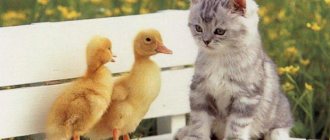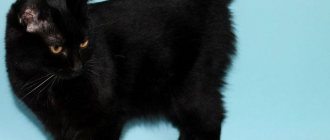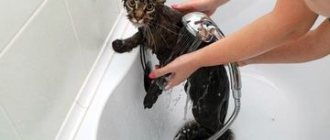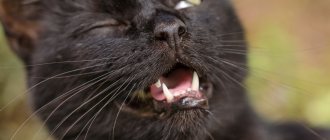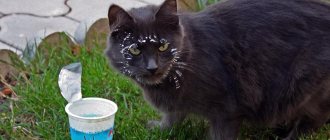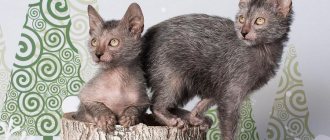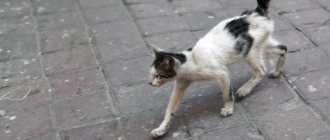Unfortunately, many of us are forced to give up cats because one of our family members is allergic to them. What then should you do if the desire to have a pet is so strong that life is not a joy without a four-legged friend? There is a solution - these are hypoallergenic cats, wonderful affectionate creatures that do not cause coughing attacks, do not itch their eyes, and do not cause rashes on the skin. Moreover, there are many such breeds for every taste. Another thing is that when looking for a pet, you can end up with unscrupulous breeders who will pass off an ordinary kitten as hypoallergenic, and here you should be careful. How to avoid being deceived? Which cats are suitable for allergy sufferers? What are the causes of allergies? What breeds are included in the TOP 8 and are they really so wonderful? Let's try to figure it out.
Hypoallergenic cats: myth or reality?
Cat breeders immediately warn that there are no breeds that do not cause allergies. To understand this issue, you need to understand what exactly causes increased susceptibility. Research confirms that a special protein, Fel D1, is actively synthesized in the cat’s body. This compound causes allergic reactions in humans.
Allergies are caused by a specific protein, which is produced in different quantities in all breeds.
Some breeds produce a lot of this protein, so the likelihood of developing allergies will be high. As for hypoallergenic cats, the production of Fel D1 in their bodies is slow. Its concentration will be lower, therefore the likelihood of developing unpleasant symptoms upon contact with an animal decreases.
It is generally accepted that allergies are caused by animal fur, but the protein, which is dangerous to humans, is usually found in biological fluids, including urine and saliva. Thick hair only helps the allergen spread faster throughout the room.
The thicker the fur, the faster allergens spread throughout the room.
This fact suggests that even those with thick fur can theoretically be hypoallergenic, provided that these cats produce little Fel D1 protein.
What to look for when choosing a breed?
Hypoallergenic cats do exist, but you need to choose a breed responsibly. Experts advise taking into account several nuances:
- The risk of developing allergies will be higher if the cat has not only long hair, but also a thick undercoat. For this reason, Persian and exotic cats, as well as “British” and “Scottish” cats, are not suitable for allergy sufferers.
When choosing cats, experts advise allergy sufferers to pay attention to cats that do not have undercoat.
- Scientists have established a connection between the intensity of secretion of the allergen protein and the color of the animal. From this point of view, it is preferable to have cats with light hair.
- Fel D1 protein releases will be regular if the animal is fertile. For this reason, the cat or cat needs to be sterilized. The procedure will allow you to avoid many other problems - screaming, tags, damage to furniture in the apartment. Neutered pets are less likely to suffer from cancer, so this step is worth taking if you are not planning to actively conduct breeding work.
Choosing a hypoallergenic breed does not guarantee the absence of allergies to a specific individual.
Deciding on a breed is just the first step. Next, you need to make sure whether a particular cat will trigger an allergy in a sensitive person. This issue is especially relevant for children and asthmatics.
Cornish Rex
Gene mutation is a common cause of new cat breeds. In the 1950s in Britain, a cat appeared in one of the rabbit breeding farms whose fur consisted only of downy undercoat. Guard and intermediate hairs were absent. The fluff of the undercoat curled, so the coat of Kallibunker - that was the name of the cat - resembled astrakhan fur.
Corinish Rexes are surprising in their appearance, so much so that they are sometimes called alien cats. The body of cats is medium or small in size. The chest is voluminous, the pectoral keel is clearly visible. Due to the length of its legs, the cat looks taller than other breeds. The ears are large and emphasize the triangular shape of the head.
The coat is silky and lies in regular waves. The fur cover does not protect the animal well from temperature changes. Protecting a cat from the cold is the owner's responsibility. Otherwise the animals are unpretentious. Truly homey, friendly and playful.
How do you know if you are developing an allergy to a cat?
Signs of an allergy may appear immediately after contact with an animal, but this is rare. Typically, it takes at least 30 minutes to an hour for the first symptoms of watery eyes and itching to develop, but most often it takes even longer. When meeting an animal for the first time, allergies may not appear at all. Its signs become obvious only after a few days, when a sufficient amount of dangerous protein has accumulated.
Even before buying a kitten, it is advisable for an allergy sufferer to stay in the same area with him for some time.
To avoid such situations, you need to try to find out in advance whether the animal protein will be dangerous to humans. You can collect biomaterial, for example, cat fur and saliva, and submit it to the laboratory. Experts will check the compatibility of the Fel D1 protein with the blood of a particular person and give an opinion on the possibility of keeping this animal at home.
An allergen test will help clarify the situation.
Which cats are suitable for allergy sufferers?
As already noted, when choosing a breed for sensitive people, you should base it not only on visual preferences, but also on other signs that may indicate hypoallergenic cats.
During the molting period, an allergy to wool can also occur in people who have not previously suffered from it.
Breeders recommend immediately paying attention to the animal’s fur. Thick hair and dense undercoat indicate that the cat will shed regularly. During this period, wool spreads throughout the apartment and constantly hovers in the air. It can trigger typical symptoms even in those who have not previously suffered from allergies.
A pet’s thin undercoat or lack thereof will make life easier for an allergy sufferer.
The best choice for an asthmatic or sensitive child is a pet with short hair without an undercoat or hairless cats. However, even in this case, you will need to follow the rules of care in order to reduce the risk of deterioration in your own well-being to a minimum.
The best breeds without undercoat
The best option for an allergy sufferer is a cat with short but thin hair and no undercoat. Sensitive people can safely choose from several breeds that have these qualities.
Oriental cat
These are animals from the oriental group. They have an unusual appearance, which makes them attractive. The Oriental cat has a slender and elongated body and a long tail. She is graceful and flexible. The muzzle is slightly elongated. A distinctive feature of Orientals is their large ears.
Oriental cat
Oriental cats have short fur that lies close to the body. There is no undercoat, but the hair itself is soft and silky to the touch. Such animals rarely cause allergies, so even asthmatics can have them. Oriental cats, according to their owners, have a character that is not typical for cats. In many ways they resemble dogs. The cat becomes attached to one of the family members and always follows him. These are sociable and playful animals.
Balinese cat
This breed is suitable for those who want to keep a fluffy beauty at home. The fur of such animals is long, soft, silky, but they lack undercoat, so molting is weakly expressed.
Balinese cat
The Balinese cat has beautiful blue eyes and a typical coloration with a light body and darkening on the ears, tail, and paws. These are friendly, sociable and flexible cats that are ideal for families with children.
Balinese cat
Balinese dogs are also considered hypoallergenic. Their fur is long, but soft and fine. It rarely provokes unpleasant symptoms in cat owners. Externally, Balinese cats resemble Siamese cats, but differ from them precisely in the length of their fur. This breed originated in the east, but the main credit for its international recognition belongs to American breeders.
Balinese cat
The Balinese cat is a beautiful, slender and graceful animal with a proportional wedge-shaped head, wide-set ears and almond-shaped eyes. The typical color for a Balinese is color point. These cats have a light body, a characteristic “mask” on the face, a darkened tail and the tips of the paws.
Balinese cats are intelligent and energetic. These cats cannot stand loneliness. They constantly need company. Owners of Balinese dogs can safely bring other animals into their homes. Cats get along great with them.
learn more about the character of the Balinese cat, the breed standard, and the features of caring for it on our portal.
Javanese cat
This breed is a hybrid of two others - Balinese and Siamese. These animals are of medium size. Their weight usually does not exceed 5 kg. The body is strong-muscled, slender, graceful. These cats have an elongated wedge-shaped head, a long neck, wide-set large ears and almond-shaped eyes, characteristic of many breeds of this group.
Javanese cat
Breed standards allow almost any color. Javanese can be:
- beige;
- ashy;
- white with red spots;
- chocolate;
- black.
Cat lovers should remember that for people prone to allergic reactions, animals with light fur are ideal pets.
Javanese cats love attention and value time spent with their owner.
The Javanese cat is similar in character to the Oriental cat. Such animals choose one owner for themselves and remain devoted to him throughout their lives. They require attention. You need to work with Javanese cats and come up with entertainment for them. These are very active and curious pets by nature.
Ocicat
A breed in whose genetic makeup there is no connection with wild cats. However, it got its name from a wild Central American cat, the ocelot. The reason for borrowing part of the name is related to the color of the cat: it is very reminiscent of the fur of a wild predator.
The extravagant cat was obtained through the efforts of breeder Virginia Dale. Mixing Abyssinian and Siamese cats and involving geneticists gave a beautiful result - the Ocicat breed. As an established cat species, the Ocicat was registered by the American Feline Association in 1987.
The weight of the cats is noticeable. Females gain weight up to 3.5 kg. Males are much larger - up to 6 kg. The backbone is strong. The muscles are well developed. The coat is short-haired. The main color is expressive: dark, medium-sized oval spots are scattered across a sandy-gray background. The breed standard approves 12 color options.
Ocicats are sociable animals. They can coexist next to other pets, even small ones. They are intelligent, not stubborn, and well trained. Their behavior resembles that of dogs. They feel bad when the owner begins to completely ignore them.
The best breeds with a minimum of wool
Those cats that have no hair at all will also be hypoallergenic. These are the so-called hairless or hairless animals. Not everyone likes such breeds, but most of them are famous for their high intelligence and docile nature.
Canadian Sphynx
This is one of the first breeds of hairless cats to appear. If a person is prone to allergies, then it is worth choosing this one. Canadian Sphynx cats are not like other cats. Their peculiarity is the complete absence of standard wool. Instead, there is fluff, so the cat will feel velvety to the touch. The body of the animal is rounded, the skin forms many folds. Its shades can be different - plain or with spots. The “Canadians” have a long, whip-like tail, pointed at the end.
Canadian Sphynx
The animal's face also looks unusual. The Canadian Sphynx has large round eyes, clear cheekbones, and wide-set ears. There should be no whiskers, but whiskers are present above the eyebrows.
Canadian Sphynx cats have elevated body temperatures. This is considered the norm for animals without fur. For an adult cat, the normal temperature is 39-40°C. Kittens have an even higher temperature - 42°C.
Despite their strict look, Canadian Sphynx cats easily get along with people
Canadian Sphynx cats are considered ideal pets for families with small children. These cats are affectionate and friendly. They don't get angry, don't hiss, and don't scratch. They are not characterized by aggressiveness. These are mobile and active animals that become attached to humans.
Don Sphynx
This is another option for cats without hair, and, unlike Canadians, these sphinxes may have no hair at all. To purchase a completely hairless cat, you need to pay attention to the type that the breeder will name. There are 4 of them in total, and they are discussed in more detail in the table.
Table. Types of Don Sphynxes
| Type | Description |
Naked | There is no wool or fluff. The cat's skin is absolutely smooth. The epidermis feels like a rubber coating to the touch. |
Flock | The animal's skin is covered with many short, straight hairs. They are soft and thin, almost invisible. Skin feels like a peach |
Velours | The skin is covered with hairs 2-3 mm long. They are clearly visible to the naked eye. Hair may fall out, leaving the skin surface smooth |
Brush | These cats have hair, but it is sparse, hard, crimped, and lies tightly to the body. |
The Don Sphynxes are visually different from the “Canadians” in that they have a more massive build, their skin has many more folds, and their ears are narrower and set higher. The eyes of the Don Sphynx are narrow, elongated, and have a stern look.
Don Sphynx kittens
The Don Sphynx is an excellent option for apartment living. This cat does not shed and does not smell. Cats practically do not mark their territory. These are smart cats that are litter trained without problems. They become attached to their owner, but can be touchy.
Peterbald
This breed is considered young. She was bred in Russia by crossing an Oriental cat with a Don Sphynx. The Peterbald (Petersburg Sphynx) is an elegant and slender animal. They have a straight profile, large ears, and almond-shaped expressive eyes. Peterbalds' skin varies, but all colors are considered hypoallergenic. Among the representatives of the breed there are all types characteristic of sphinxes:
- brush;
- flock;
- velours;
- naked.
St. Petersburg sphinxes
There are also straight-haired varieties. Such kittens are born in the absence of the gene responsible for hairless skin. Outwardly, such cats resemble their closest relatives - Balinese or Javanese.
The Peterbald is a companion cat. This is a calm and kind animal that requires the company of other pets or people. These are unforgiving and non-aggressive cats.
Sphinx
Hairless cat breed. The complete absence of fur is the result of a natural genetic failure. There have been periodic reports of hairless kittens. Breeders became interested in them around 1960. The date of complete formation of the breed can be considered 1970.
The North American version of the Sphinx is called the Canadian Sphinx. Two varieties of the Sphynx, the Donskoy and the Peterbald, were later bred in Russia. In Ukraine, a breed called the “Ukrainian Levkoy” was developed. That is, the Sphynx is a group of cat breeds.
Sphynx cats are moderate-sized cats. The body is muscular with a rounded chest and a noticeable belly. The head is wedge-shaped with large eyes and an elongated nose. The mustache pads are modest. The ears are large, with a slight deviation to the sides. Limbs of normal size. The hind ones are slightly longer than the front ones.
Hairlessness is not absolute. On the entire body or selectively: downy hair can grow on the tail and paws. Cats are smart. Attached to the owner. Need constant attention. In many ways, their behavior depends on relationships with people at a very early age.
The best shorthaired breeds
Those who cannot decide on a completely hairless cat should take a closer look at alternative options. Hypoallergenic breeds have been bred that have short coats.
Cornish Rex
Cats of this breed have a unique coat consisting of soft curly hairs, closely resembling astrakhan fur. They have no guard hairs, and the entire cover is represented exclusively by undercoat. It falls in a dense wave. These cats are smooth and silky to the touch.
Cornish Rex
The Cornish Rex is a medium-sized cat with a wedge-shaped head and large ears. The eyes are round and bright. The coat color can be different, including spotted. Cornish Rexes are ideal indoor cats. They are calm, rarely get sick, but are prone to overeating. This is worth considering for those who decide to purchase such a cat.
Devon Rex
The appearance of representatives of this breed resembles the Cornish Rex, but they are not considered relatives. The Devon Rex has soft curls of undercoat on its back. The fur itself is small, the cat practically does not shed.
Devon Rex kittens
These are graceful cats with a strong body, a small head and a flat muzzle. They have large round eyes and wide-set ears. Devon Rexes have well-developed limbs, thanks to which the cats have high mobility and jumping ability. Devon Rexes have an easygoing disposition. They have close contact with humans and remain playful even into adulthood.
Russian blue
Two blue kittens were exported from Arkhangelsk to Britain in 1860. A short sea voyage marked the beginning of the now popular breed - Russian Blue. According to another version, back in the 18th century, so-called “sea” cats were known in Arkhangelsk. They were not at all afraid of water and successfully destroyed ship rats. On merchant ships, cats came to Britain and became the ancestors of the Russian Blue breed.
From England, cats spread across Europe and went overseas. Russian Blues have crossed with other domestic cats, but have retained their best qualities. Blue cats from Arkhangelsk are moderate-sized animals with short, plush hair.
The cat has a wedge-shaped head, the ears are set vertically. Muzzle with well defined whisker pads and large, almond-shaped, almost round eyes. The emerald green gaze of the widely spaced eyes seems meaningful and very attentive.
The body is muscular, the bones are of medium weight. The color is uniform, gray-blue. There may be a predominance of gray or blue tones. The Russian Blue's character is soft and delicate. The cat is responsive, but not intrusive. Oriental is a hypoallergenic cat breed ; Almost ideal for children
Long-haired hypoallergenic cats
It is difficult to choose a cat breed that will definitely not provoke allergies. As a rule, these are hairless sphinxes or unusual-looking orientals and balineses. Many people like long-haired fluffy beauties. As noted by breeders and cat lovers, even among such breeds you can find hypoallergenic options.
Siberian cat
This is a native Russian breed of strong and muscular animals. Their body is covered with thick and long hair, which protects them from adverse external conditions. This type of fur rarely causes allergies. This feature is associated with the low intensity of secretion of the protein responsible for the formation of allergic reactions in humans. Siberians produce 20% less Fel D1 than cats of other breeds.
Despite the presence of thick, velvety fur, Siberian cats get along well with allergy sufferers
Representatives of the Siberian breed have excellent health and require minimal care. It is important to regularly comb the coat, clean the ears, and remove tartar. Siberian cats are flexible by nature. They are smart and attached to humans. They quickly remember their name and respond to it. “Siberians” become full-fledged members of the family in which they live.
Legends about the harsh disposition of “Siberians” do not prevent them from finding common ground with their households
Video - Features of caring for a Siberian cat
Burma
The European standard assumes that the Burmese cat is a slender animal. With an elongated triangular muzzle and ears, with voluminous shells. According to the European version, the limbs should be long, emphasizing the lightness of the cat.
In accordance with American views, the Burmese breed unites strong, squat animals. With a fairly wide head, short, flattened muzzle. Limbs and tail without excessive elongation, of medium length.
In both versions, the standards describe muscular cats weighing between 4 and 6 kg. A short, silky coat is expected. There should be no sharp color transitions in color. The usual color is brown sable. The whole range of brown shades is allowed. In recent years, the range of acceptable colors has expanded significantly.
By nature, Burmese cats are playful from infancy to old age. They are attached to their owners like a dog. They do not cope well with even short-term separation. A feature of the breed is its unartistic vocals, inherited from Siamese cats. Although you can already hear melodic notes in the Burmese voice.
How to properly care for a cat?
A cat will be hypoallergenic only if it is properly cared for. The body of any animal produces a dangerous protein, so it is important to ensure that it cannot spread throughout the room where the cat is kept. Following basic hygiene rules will help prevent its distribution.
- The animal needs to be washed. Short-haired cats are bathed more often than long-haired Siberians.
Regular bathing of your pet allows you to minimize the risk of developing allergies in the owner.
- If there is no hair, then regular wiping of the body with a damp cloth or napkin would be appropriate.
- Cats with fur need to be brushed regularly. It is better to carry out this procedure outdoors or in a well-ventilated area.
Today, any pet store has slickers, brushes and furminators.
- You need to monitor your pet's health. Poisoning and intestinal disorders should not be allowed, as this condition increases the rate of spread of the dangerous protein.
It is important to take a responsible approach to keeping an animal in your apartment. The more fur that accumulates on furniture surfaces, the higher the risk of allergies, so do not neglect regular wet cleaning.
The well-being of allergy sufferers depends on timely wet cleaning
It is better to abandon carpeting and opt for a smooth floor - linoleum or laminate. All textile interior items - curtains, bedspreads, decorative pillows - need to be washed regularly. In this case, the risk of developing a cat allergy will be minimized.
The skin of sphinxes not protected by fur requires special attention. We'll talk about how to keep representatives of the breed clean below.
Sphinx bathing
Price for hypoallergenic cats
It is unlikely that you will be able to purchase an animal that will not cause allergies cheaply. It is important to buy a cat from breeders who guarantee the purity of the breed. Prices in nurseries vary. The final cost always depends on the class of the kitten. Pets for home care are cheaper than show-class pets used for breeding. On average, the price range is as follows:
- The price for a kitten of the Siberian breed starts at 7,000-10,000 rubles.
- Devon or Cornish Rex cost at least 12,000.
- Those wishing to purchase a Sphynx need to be prepared for a price tag of 15,000 rubles, and completely naked options usually cost more and are valued higher.
- The price for an Oriental breed kitten starts at 10,000-12,000 rubles.
- The cost of a Balinese cat for home keeping is 15,000 rubles.
It is not recommended to take purebred cats from your hands - you will receive complete information about the animal only from the breeder
It is important to understand that a cat quickly becomes attached to a place and a person. You should not purchase an animal unless you are sure that allergies will not occur. If you really want to have a pet, it is best to first familiarize yourself with the list of hypoallergenic breeds, choose a nursery and test the animal’s saliva for the presence of dangerous proteins.

